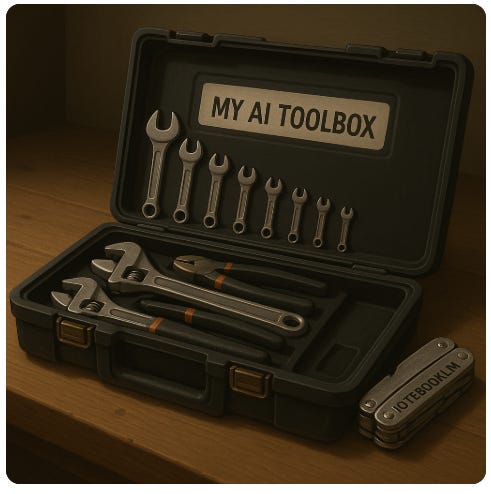130 | NotebookLM: The Unsung Hero of My AI Toolkit
I was actually an early fan of NotebookLM. From the beginning, I appreciated its promise—but only recently have I found myself turning to it regularly.
NotebookLM has earned a spot in my actual workflow, becoming my go-to for specific tasks that used to feel overwhelming. It’s not a replacement for everything, but I’ve discovered two specific ways to use it that I know I’ll come back to again and again.
Learning Something New, with Structure
The breakthrough moment came when I discovered how powerful the combination of NotebookLM's "Discover Sources" and Mind Map features could be. Instead of feeling like I was drowning in information, suddenly I had both a curated set of materials and a way to make sense of them visually.
Picture this: you're faced with a mountain of new information—maybe it's new grant guidelines, or a policy change affecting your sector. The old approach meant bookmarking dozens of articles and hoping you'd remember the connections later.
Now, with "Discover Sources" gathering everything in one place and Mind Maps helping to visualize how concepts connect, I could create a coherent, structured learning path, something that felt tailored and truly manageable.
Here's how this played out recently for me: After the Google I/O 2025 event, I was overwhelmed by the sheer breadth of announcements—everything from developer tools to new versions of Google glasses. Those aren’t my primary interests at the moment … rather, I was keen to dive into updates on Workspace, Meet, NotebookLM, and other tools that matter more in my world. I gathered official Google recaps and commentary from outlets like The Verge, created a NotebookLM notebook, pulled in 20 or so sources, and built a Mind Map to categorize the content. Instead of reading everything linearly, I used the chat feature to explore topics most relevant to me. What could have been hours of scattered reading became a tailored learning journey with organized notes I can go back to later.
Digging Deeper with Videos and Your Own Perspective
The second of my two discoveries takes things in a different direction—but it's just as impactful.
I heard an episode of The Daily Brief—my favorite AI podcast—where host Nathaniel Whittemore broke down the various ChatGPT models. Instead of needing to replay sections over and over whenever I wanted to revisit what he said about the mess of models, I added the YouTube version of the episode to a NotebookLM notebook. I used a Mind Map to organize the topics he covered, then chatted with NotebookLM to explore the nuances from my perspective. Which models work best for writing? Which are most cost-effective?
Then, I created a Briefing Document summarizing the episode's content. Now I have my own reference guide for choosing ChatGPT models, built from exactly the sources I trust. Nice!
Why This Might Matter to You Too
Think about your organization's information challenges: new grant guidelines, policy shifts, technology updates that could streamline operations but require understanding complex documentation.
NotebookLM excels at transforming overwhelming information into structured knowledge. Instead of drowning in documentation, you create learning journeys tailored to your organization's needs. If you have the information, maybe in PDFs someone emailed to you, you can upload it. Augment that or just start from scratch with sources NotebookLM finds through its Discover Sources option. Then, Mind Maps help you see connections, while the chat feature lets you explore implications relevant to your work. (And I haven’t even gotten into the viral NotebookLM feature, Audio Overview, a/k/a podcasts!)
NotebookLM: Not Flashy, Just Incredibly Useful
NotebookLM isn’t your all-purpose AI sidekick, but it shines when you're juggling lots of complex information. Whether you're trying to untangle a dense document set or make sense of a packed video, it’s a practical, focused tool that can lighten the load.
So next time information overload hits, consider opening a NotebookLM notebook. Add your sources, build a Mind Map, and start asking questions.
It’s not the flashiest AI tool in your kit, but used thoughtfully, it just might become one of your most valuable tools. So when the slicker tools catch your eye, remember—sometimes the quiet workhorse is the one that gets it done. And as always,
Make Good Choices.



